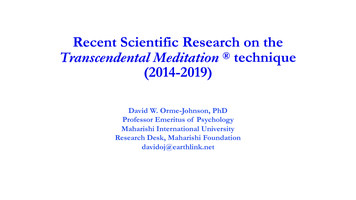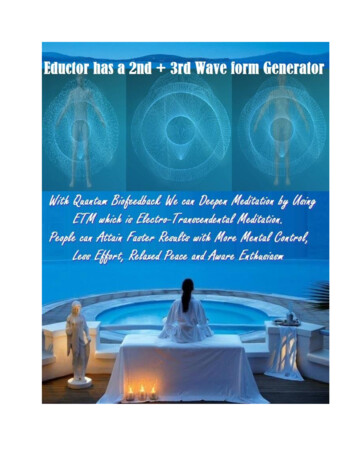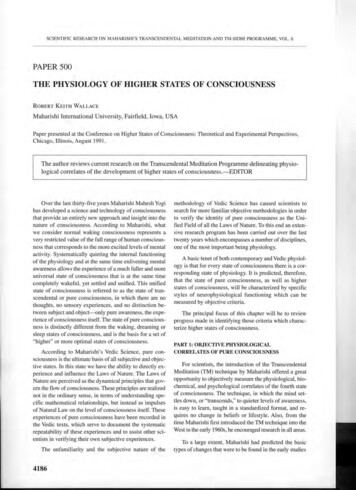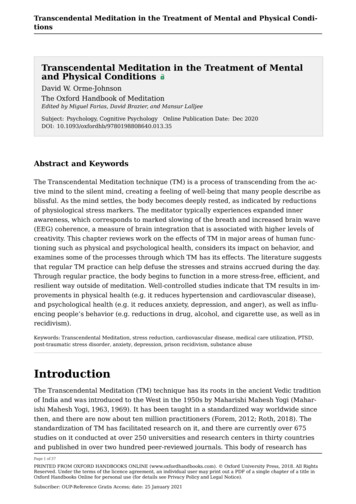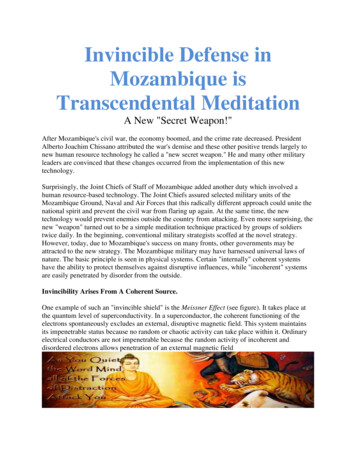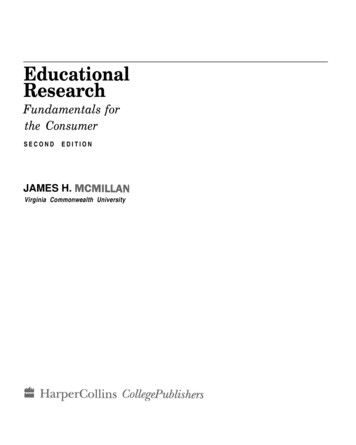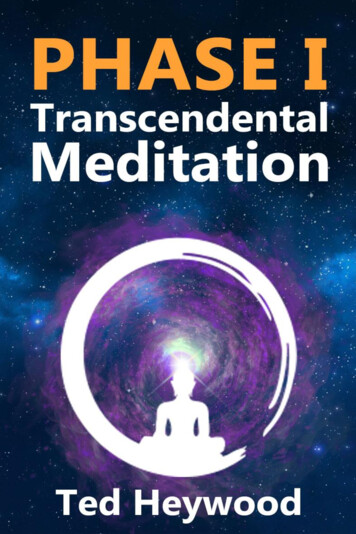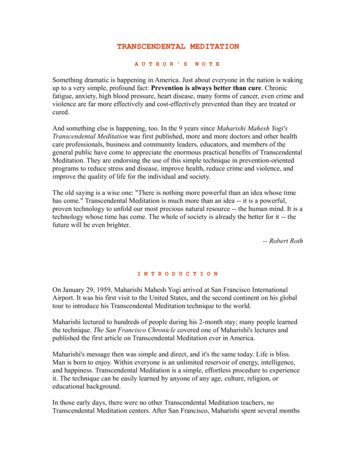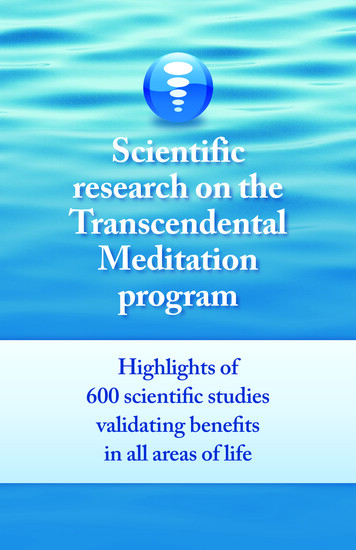
Transcription
Scientificresearch on theTranscendentalMeditationprogramHighlights of600 scientific studiesvalidating benefitsin all areas of life
SCIENTIFIC RESEARCH ON THETRANSCENDENTAL MEDITATION AND TM-SIDHI PROGRAMSPHYSIOLOGICAL FUNCTIONINGPhysiological Indicators of Deep RestIncreased Integration of Brain Functioning-.4--.6-.8-Respiratory alMeditationtechniquep .05Eyes-closed restTranscendentalMeditationtechniquep .05Plasma chniquep .01TM techniqueA meta-analysis (used for drawing objective conclusions from large bodiesof research) found that the Transcendental Meditation technique produceda significant decrease in basal skin conductance compared to eyes-closedrest, indicating profound relaxation. Deep rest and relaxation were alsoindicated by greater decreases in respiration rates and plasma lactate levelscompared to ordinary rest. These physiological changes occur spontaneouslyas the mind effortlessly settles to the state of restful alertness, Transcendental niqueReference: International Journal of Psychophysiology 71 (2009): 170–176.F I N D I N G SI NT H EA R E AO FP H Y S I O L O G I C A LEffects During the PracticeEffects of the Practice in Daily Life Increased EEG Coherence Increased EEG Coherence I ncreased Stability of theAutonomic Nervous System I ncreased Efficiency of InformationTransfer in the Brain Faster Recovery from Stress References: 1. International Journal of Neuroscience116 (2006): 1519–1538.2. Psychosomatic Medicine 46 (1984): 267–276.3. International Journal of Neuroscience 14 (1981):147–151. Increased Blood Flow to the Brain References: 1. Physiology & Behavior 59 (1996): 399–402.2. American Journal of Physiology 235(1) (1978): R89–R92. Increased Muscle Relaxation References: 1. Electroencephalography and ClinicalNeurophysiology 35 (1973): 143–151.2. Psychopathometrie 4 (1978): 437–438. D ecreased Stress Hormone(Plasma Cortisol)2p .0001University students who learned the Transcendental Meditation technique,in contrast to students randomly assigned to a delayed-start group, showedsignificant improvement over a 10-week period on a Brain Integration Scalecomprising several EEG measures during task performance. Components ofthe Brain Integration Scale on which improvement was measured includedincreased broadband frontal EEG coherence and more efficient preparatorybrain responses to stimuli. Students learning the Transcendental Meditationtechnique also showed decreased sleepiness and faster habituation to stressfulstimuli in comparison to controls.References: 1. American Psychologist 42 (1987): 879–881.2. Science 167 (1970): 1751–1754.3. American Journal of Physiology 221 (1971): 795–799.A D D I T I O N A 0.4-0.5-0.6- References: 1. Hormones and Behavior 10 (1978): 54–60.2. Journal of Biomedicine 1 (1980): 73–88. 3. Clinical and Experimental Pharmacology and Physiology 7(1980): 75–76.4. Experientia 34 (1978): 618–619. 0--.2-Basal SkinConductanceTHROUGH THE TRANSCENDENTAL MEDITATION TECHNIQUEChange inBrain Integration ScaleChange from before practiceto during practiceTHROUGH THE TRANSCENDENTAL MEDITATION TECHNIQUE Reference: Biological Psychology 61 (2002): 293–319. References: 1. Motivation, Motor and Sensory Processes ofthe Brain, Progress in Brain Research 54 (1980): 447–453. 2. International Journal of Neuroscience 10 (1980): 165–170.3. Psychophysiology 26 (1989): 529. 4. Zeitschrift für Elektroenzephalographie undElektromyographie EEG-EMG [Journal ofElectroencephalography and Electromyography] 7 (1976):99–103. L ower Baseline Levels of Heart Rate,Respiration Rate, Plasma Lactate,and Spontaneous Skin ResistanceResponses References: 1. American Psychologist 42 (1987): 879–881.2. L’Encéphale [The Brain] 10 (1984): 139–144. References: 1. Psychosomatic Medicine 35 (1973): 341–349.2. Psychosomatic Medicine 44 (1982): 133–153. References: 1. Psychosomatic Medicine 35 (1973): 341–349. 2. International Journal of Neuroscience 46 (1989): 77–86. M obilization of theLatent Reserves of the BrainReference: Human Physiology 25 (1999): 171–180.F U N C T I O N I N G L ess Emotional Sensitivity toStress, Indicated by Neuroimagingof Brain Activation Reference: Cognitive Neuroscience and Neuropsychology 17(2006): 1359–1363. Faster Reactions References: 1. Personality and Individual Differences12 (1991): 1105–1116. 2. Perceptual and Motor Skills 38 (1974): 1263–1268.3. L’Encéphale [The Brain] 10 (1984): 139–144. Faster Reflex Responses Reference: Perceptual and Motor Skills 50 (1980): 1103–1106.C O N C L U S I O NDuring the practice of the Transcendental Meditation technique, the body gains aunique state of deep rest that dissolves accumulated stress and fatigue. At the sametime, brain functioning becomes more orderly. As a result, the body becomes healthier and more inte grated, leading to greater success in dynamic activity.3
MENTAL POTENTIALSCIENTIFIC RESEARCH ON THETRANSCENDENTAL MEDITATION AND TM-SIDHI PROGRAMSOptimization of Brain FunctioningHolistic Improvement in Intellectual PerformanceTHROUGH THE TRANSCENDENTAL MEDITATION TECHNIQUETranscendentalConsciousnessr .43r .31.1-GradePointAverage.0- Enhanced Creativity References: 1. The Journal of Creative Behavior 13 (1979):169–180. 2. The Journal of Creative Behavior 19 (1985): 270–275. 3. Intelligence 29 (2001): 419–440. I ncreased Field Independence—Broader Comprehension andImproved Ability to Focus Attention References: 1. Perceptual and Motor Skills 39 (1974): 1031–1034. 2. Perceptual and Motor Skills 59 (1984): 999–1000. 3. Perceptual and Motor Skills 62 (1986): 731–738. 4. Intelligence 29 (2001): 419–440. I ncreased Efficiency ofPerception and Memory Reference: Memory & Cognition 10 (1982): 207–215.4Creativityp .0001References: The chart above refers to data from the following four studies:1. International Journal of Neuroscience 13 (1981): 211–217.2. International Journal of Neuroscience 15 (1981): 151–157.3. Scientific Research on the Transcendental Meditation Program: Collected Papers, Volume 1 (1977): 208 –212.4. Scientific Research on Maharishi’s Transcendental Meditation and TM-Sidhi Programme: Collected Papers, Volume 4 (1989): 2245–2266.F I N D I N G S.3.2-Higher levels of EEG coherence meas ured during the practice of the Transcendental Meditation technique are significantly correlated with increasedfluency of verbal creativity; increased efficiency in learning new concepts;more principled moral reasoning, higher verbal IQ, and decreased neuroticism; higher academic achievement; clearer experiences of TranscendentalConsciousness; and increased neurological efficiency, as measured by fasterrecovery of the paired H-reflex.A D D I T I O N A L.5.4- R .63MoralReasoning,IQ, DecreasedNeuroticism EEGCoherencer .60H-reflexr .50 r .71.7.6-Effect sizeCreativity .8-ConceptLearning THROUGH THE TRANSCENDENTAL MEDITATION TECHNIQUEI NT H E I mproved Left HemisphericFunctioning—Improved Verbaland Analytical Thinking References: 1. Gedrag: Tijdschrift voor Psychologie [Behavior:Journal of Psychology] 3 (1975): 167–182.2. The Journal of Creative Behavior 13 (1979): 169–180. 3. The Journal of Creative Behavior 19 (1985): 270–275.4. Perceptual and Motor Skills 62 (1986): 731–738. I mproved Right HemisphericFunctioning—Improved Syntheticand Holistic Thinking References: 1. Biofeedback and Self-Regulation 2 (1977):407–415.2. The Journal of Creative Behavior 13 (1979): 169–180.3. Journal of Clinical Psychology 42 (1986): 161–164.PracticalFieldIntelligence Independencep .0001p .0001MentalEfficiencyp .0003FluidIntelligencep .001Three randomized controlled studies among secondary school and vocationalschool students found that, in contrast to controls, those who learned theTranscendental Meditation technique showed significant improvement in fivemeasures of intellectual functioning; they also showed decreased anxiety.References: 1. Intelligence 29 (2001): 419–440.2. Personality and Individual Differences 12 (1991): 1105–1116.3. Perceptual and Motor Skills 62 (1986): 731–738.4. College Student Journal 15 (1981): 140–146.5. The Journal of Creative Behavior 19 (1985): 270–275.6. Journal of Clinical Psychology 42 (1986): 161–164.7. Gedrag: Tijdschrift voor Psychologie [Behavior: Journal of Psychology] 3 (1975): 167–182.A R E AO FM E N T A L A ccelerated CognitiveDevelopment in Children References: 1. Perceptual and Motor Skills 65 (1987): 613–614.2. Journal of Social Behavior and Personality 17 (2005): 21–46.3. Journal of Social Behavior and Personality 17 (2005):47–64.4. Journal of Social Behavior and Personality 17 (2005):65–91.P O T E N T I A L Increased Liveliness Reference: Zeitschrift für Klinische Psychologie [Journal forClinical Psychology] 7 (1978): 235–255. I ncreased Cognitive Flexibilityin the Elderly Reference: Journal of Personality and Social Psychology 57(1989): 950–964.C O N C L U S I O NDuring the practice of the Transcendental Meditation and TM-Sidhi programs,the mind experiences Transcendental Consciousness—the state of unboundedawareness, the basis of creativity and intelligence. This experience stim ulates amore coherent style of brain functioning and results in more comprehensive, focused,creative, and intelligent thinking.5
SCIENTIFIC RESEARCH ON THETRANSCENDENTAL MEDITATION AND TM-SIDHI PROGRAMSEDUCATIONImproved Postgraduate Academic PerformanceIncreased Self-Actualization100%-THROUGH THE TRANSCENDENTAL MEDITATION TECHNIQUEp .02Adjusted mean effect size(standard deviation)60%40%20%0%-BeforeAfter theTranscendentalMeditation techniqueTranscendentalMeditationtechnique0.8- 80%- Percentage of tests withTM group higher than controlsTHROUGH THE TRANSCENDENTAL MEDITATION TECHNIQUE0.60.4-Concentration orContemplationOtherTechniques0.20.0-p .0002Statistical meta-analysis of all available studies (42 independent outcomes)indicated that the effect of the Transcendental Meditation program on increasing self-actualization is much greater than concentration, contemplation, orother techniques. Self-actualization refers to realizing more of one’s innerpotential, expressed in every area of life: integration and stability of personality,self-regard, emotional maturity, capacity for warm interpersonal relationships,and adaptive response to challenges.Master’s degree engineering students who learned the Transcendental Meditation program showed improved performance on their standard examinations after six months, compared with randomly assigned control studentsfrom the same academic program.Reference: British Journal of Educational Psychology 55 (1985): 164–166.References: 1. Journal of Social Behavior and Personality 6 (1991): 189–248.2. Journal of Counseling Psychology 19 (1972): 184–187.3. Journal of Counseling Psychology 20 (1973): 565–566.A D D I T I O N A L Increased Intelligence inSecondary and College StudentsReferences: 1. Intelligence 29 (2001): 419–440.2. Journal of Personality and Individual Differences 12 (1991):1105–1116. 3. Perceptual and Motor Skills 62 (1986): 731–738. 4. Dissertation Abstracts International 38(7) (1978):3372B–3373B. I mproved Performance in PrimarySchool, Secondary School, andUndergraduate Students References: 1. Education 107 (1986): 49–54.2. Education 109 (1989): 302–304. Improved MemoryReferences: 1. Memory & Cognition 10 (1982): 207–215. 2. Scientific Research on the Transcendental MeditationProgram: Collected Papers, Volume 1 (1977): 385–392. I ncrease in PrincipledMoral Reasoning6 Reference: Journal of Social Behavior and Personality 17(2005): 93–121.F I N D I N G S I ncreased Field Independence—Increased Resistance toDistraction and Social Pressure References: 1. Perceptual and Motor Skills 39 (1974):1031–1034.2. Perceptual and Motor Skills 59 (1984): 999–1000.3. Perceptual and Motor Skills 62 (1986): 731–738.4. Intelligence 29 (2001): 419–440. G reater Interest inAcademic Activities References: 1. Western Psychologist 4 (1974): 104–111. 2. Dissertation Abstracts International 38(2) (1977):649A–650A. G reater Intellectual andScientific OrientationReferences: 1. Western Psychologist 4 (1974): 104–111. 2. Dissertation Abstracts International 38(2) (1977):649A–650A.I NT H EA R E AO FE D U C A T I O N I ncreased Self-Confidenceand Self-Actualization References: 1. Journal of Social Behavior and Personality 6(1991): 189–248.2. College Student Journal 15 (1981): 140–146. 3. Zeitschrift für Klinische Psychologie [Journal for ClinicalPsychology] 7 (1978): 235–255. Reduced School Behavior Problems Reference: Health and Quality of Life Outcomes 1(1) (2003):10. http://www.hqlo.com/content/1/1/10 R educed Symptoms of Attention DeficitHyperactivity Disorder (ADHD)Reference: Current Issues in Education 10(2) tml Decreased Dropout Rate Reference: Dissertation Abstracts International 38(6) (1977):3351A. Increased Self-Development Reference: Journal of Social Behavior and Personality 17(2005): 93–121.C O N C L U S I O NBy providing the experience of Transcendental Consciousness, the unified field ofnatural law, the Transcendental Meditation and TM-Sidhi programs unfold thelatent genius of every student. As one’s mind becomes alert and comprehensive,increasingly thought and action are nourishing and progressive for oneself and others, and one makes fewer and fewer mistakes in life—spontaneously one lives morein harmony with natural law.7
Decreased Blood Pressure Among HypertensivesDecreased Insulin ResistanceTHROUGH THE TRANSCENDENTAL MEDITATION TECHNIQUETHROUGH THE TRANSCENDENTAL MEDITATION TECHNIQUE6-Homeostasis modelassessment of insulin resistanceSCIENTIFIC RESEARCH ON THETRANSCENDENTAL MEDITATION AND TM-SIDHI PROGRAMSChange in systolic blood e-2-StressManagement-4-6-p hnique0.30-HealthEducation-0.3-0.6-p .01-0.9-This meta-analysis was conducted on all published studies on stress reductionand blood pressure among hypertensive patients which met the criteria ofwell-designed randomized control trials with multiple studies for each treatment category. Only the Transcendental Meditation program was found tohave a statistically significant impact of reducing high blood pressure amonghypertensive subjects. A second meta-analysis conducted independently replicated the finding of significantly reduced blood pressure, both systolic anddiastolic, through the Transcendental Meditation program.This randomized controlled trial found that four months of practice of theTranscendental Meditation program led to a significant reduction in insulinresistance among individuals with stable cardiac heart disease, in contrast tocontrols receiving health education. Insulin resistance is one of the components of the “metabolic syndrome,” often associated with obesity, high bloodpressure, and hyperlipidemia—a risk factor for cardiovascular morbidity andmortality; insulin resistance may also lead to type 2 diabetes.Reduction of AtherosclerosisReduced Rates of Death, Heart Attack, and StrokeReferences: 1. Archives of Internal Medicine 166 (2006): 1218–1224.,References: 1. Current Hypertension Reports 9 (2007): 520–528.2. American Journal of Hypertension 21 (2008): nique.050-.05-HealthEducation-.10-.15-p .05This study found that those who learned the TM program showed reducedthickening of the carotid artery. This finding was in contrast to continuedthickening of this artery among a control group who took a health educationprogram on diet and exercise for alleviating cardiovascular problems. Reducedatherosclerosis in the carotid artery has been found to correlate with less diseaseof the arteries in the heart and brain, which leads to lower rates of heart attacksand strokes.8Reference: Stroke 31 (2000): 568–573.THROUGH THE TRANSCENDENTAL MEDITATION TECHNIQUERisk of events (expected number of eventsper year per 1,000 event-free persons)Change in cardiointima-media thickness (mm)THROUGH THE TRANSCENDENTAL MEDITATION TECHNIQUE120110-100-Difference betweengroups 66% over anaverage of 5 years90-8070-p .0036050-4030-HealthEducation20100-Health EducationTranscendentalMeditationtechniqueThe results of a randomized controlled trial of subjects who had known heartdisease and who participated in the TM program or a health education controlgroup showed a 47% lower risk for death, heart attack, and stroke in the TMgroup over an average of five years compared to controls. All subjects continued their standard medical care during the study. Results suggest that the TMtechnique is a new, effective method to reduce the risk of cardiovascular disease.Reference: Archives of Internal Medicine, in press.9
HealthSCIENTIFIC RESEARCH ON THETRANSCENDENTAL MEDITATION AND TM-SIDHI PROGRAMSDecreased Hospitalization and Outpatient VisitsFewer Hospital Admissions for All Disease Categories0-Ages19–39Ages40 -20%-THROUGH THE TRANSCENDENTAL MEDITATION TECHNIQUEAdmissions per 1,000 membersDecreased HospitalizationAges0–18Percent decrease in outpatient visitscompared to similar groupsPercent decrease in hospital dayscompared to similar groupsTHROUGH THE TRANSCENDENTAL MEDITATION TECHNIQUEDecreased Outpatient Visits0-Ages0–18Ages19–39Ages40 -20%--40%--40%--60%--60%-p .0001-80%--80%-p .0001A five-year study of medical care utilization statistics on 2,000 peoplethroughout the U.S. who regularly practiced the Transcendental Meditationprogram found that their overall rate of hospitalization was 56% lower thanthe norm. The group practicing the Transcendental Meditation techniquehad fewer hospital admissions in all disease categories compared to thenorm (see chart on p. 15). The highest rates of reduction in both hospitalization and outpatient visits occurred in the 40 age group, which normallyhas a higher rate of health care utilization than younger age groups, resulting in substantial cost savings.20-TM techniquep .0000115-Other Groups1050-IntestinalNose,Throat,LungHeartGenital &UrinaryInjuriesTumorsBone &MuscleIll-DefinedConditionAll -A five-year study of medical care utilization statistics of people practicingthe Transcendental Meditation program (mean N 1,468) found an overall56% reduction in hospitalization rate compared to the norm. In terms of theleading causes of death in the U.S., the findings include –87% for heart andcerebrovascular disease, –55% for cancer, –73% for nose, throat, and lungdiseases, –63% for injuries, –87% for diseases of the nervous system, including Alzheimer’s, and –65.4% for metabolic diseases, including diabetes.Reference: Psychosomatic Medicine 49(1) (1987): 493-507.References: 1. Psychosomatic Medicine 49 (1987): 493–507.2. American Journal of Managed Care 3 (1997): 135–144.A D D I T I O N A L I ncreased Functional Capacity amongCongestive Heart Failure Patients Reference: 1. Ethnicity & Disease 17 (2007): 72–77. D ecreased Blood Pressure inHypertensive Subjects References: 1. Current Hypertension Reports 9 (2007):520–528.2. Hypertension 26 (1995): 820–827.3. Hypertension 28 (1996): 228–237. 4. Journal of Personality and Social Psychology 57 (1989):950–964. Decreased Serum Cholesterol Levels References: 1. Journal of Human Stress 5 (1979): 24–27.2. Journal of Biomedicine 1 (1980): 73–88. 3. Harefuah [Journal of the Israel Medical Association] 95(1978): 1–2. I ncreased Exercise Tolerancein Angina Patients References: 1. American Journal of Cardiology 77 (1996):10867–870.2. American Journal of Cardiology 85 (2000): 653–655.F I N D I N G S Decreased Health Care ExpendituresReferences: 1. American Journal of Health Promotion 10(1996): 208–216.2. American Journal of Managed Care 3 (1997): 135–144.3. American Journal of Health Promotion 14 (2000): 284–291.4. Journal of Social Behavior and Personality 17 (2005): 415–442. Decreased Smoking References: 1. International Journal of the Addictions 12(1977): 729–754. 2. Bulletin of the Society of Psychologists in AddictiveBehaviors 2 (1983): 28–33. 3. International Journal of the Addictions 26 (1991): 293–325.4. Alcoholism Treatment Quarterly 11 (1994): 13–87. Decreased Alcohol Use References: 1. American Journal of Psychiatry 132 (1975):942–945. 2. Journal of Counseling and Development 64 (1985):212–215.3. Alcoholism Treatment Quarterly 11 (1994): 13–87. Younger Biological AgeReferences: 1. International Journal of Neuroscience 16(1982): 53–58.2. Journal of Behavioral Medicine 15 (1992): 327–341.I NT H EA R E AO FH E A L T H Decreased Insomnia References: 1. The New Zealand Family Physician 9 (1982):62–65. 2. Journal of Counseling and Development 64 (1985): 212–215. 3. Japanese Journal of Public Health 37 (1990): 729. Healthier Response to Stress References: 1. Psychosomatic Medicine 35 (1973): 341–349. 2. Journal of Counseling and Development 64 (1985): 212–215. 3. Psychosomatic Medicine 49 (1987): 212–213. 4. Journal of Psychosomatic Research 34 (1990): 29–33. D ecreased Severity ofSymptoms of Bronchial Asthma References: 1. Respiration 32 (1975): 74–80. 2. Respiratory Therapy: The Journal of Inhalation Technology 3(1973): 79–80.3. Clinical Research 21 (1973): 278. Increased Longevity Reference: 1. Journal of Personality and SocialPsychology 57 (1989): 950–964.2. Circulation 93 (1996): 19.3. American Journal of Cardiology 95 (2005): 1060–1064.C O N C L U S I O NThe deep rest and influence of orderliness provided by the Tran scen dental Meditation and TM-Sidhi programs allow the self-healing processes of the body to restorenormal, balanced physiological functioning, resulting in better general health andthe prevention of disease.11
SCIENTIFIC RESEARCH ON THETRANSCENDENTAL MEDITATION AND TM-SIDHI PROGRAMSPsychological Health and BehaviorReduced Psychological StressReduced Drug and Alcohol UseTHROUGH THE TRANSCENDENTAL MEDITATION TECHNIQUETobacco UseTranscendentalMeditationtechnique0.0-Effect sizeAdjusted mean effect size(standard deviation)THROUGH THE TRANSCENDENTAL MEDITATION TECHNIQUE-0.2-0.4--0.6-Concentration orContemplation-0.8-OtherTechniquesp rug Usep .009p .0006Standard TreatmentsA statistical meta-analysis conducted at Stanford University of all availablestudies (146 independent outcomes) indicated that the effect of the Transcendental Meditation program on reducing trait anxiety was much greaterthan that of concentration or contemplation or other techniques. Analysisshowed that these positive results could not be attributed to subject expectation, experimenter bias, or quality of research design.Alcohol UseTranscendentalMeditationtechniquep talMeditationtechniqueStandard Prevention ProgramsTranscendental Meditation techniqueA comparison of the results of several statistical meta-analyses indicated thatthe Transcendental Meditation program produced significantly larger reductionsin tobacco, alcohol, and non-prescribed drug use than standard substance abusetreatments and standard prevention programs. Whereas the effects of conventional programs typically fall off rapidly within three months, effects of the Transcendental Meditation program increase over time. The effects of the TranscendentalMeditation program are spontaneous, based on fundamental and naturally occurring improvements in the individuals’ psychophysiological functioning.References: 1. Journal of Clinical Psychology 45 (1989): 957–974.2. Journal of Clinical Psychology 33 (1977): 1076–1078.References: 1. Alcoholism Treatment Quarterly 11 (1994): 13–87.2. International Journal of the Addictions 26 (1991): 293–325.A D D I T I O N A LF I N D I N G ST H Earea I ncreased Capacity for WarmInterpersonal Relationships More Positive Self-Concept Decreased Depression O rientation TowardsPositive Values References: 1. Journal of Counseling Psychology 20 (1973):565–566. 2. Perceptual and Motor Skills 39 (1974): 623–628. 3. Zeitschrift für Klinische Psychologie [Journal for ClinicalPsychology] 7 (1978): 235–255. References: 1. Journal of Counseling and Development 64(1985): 212–215. 2. Journal of Instructional Psychology 22 (1995): 308–319. 3. Ethnicity & Disease 17 (2007): 72–77. Increased Tolerance References: 1. The Journal of Psychology 99 (1978): 121–127. 2. Dissertation Abstracts International 38(7) (1978):3372B–3373B. 3. Dissertation Abstracts International 38(8) (1978): 3895B.12I N References: 1. British Journal of Psychology 73 (1982):57–68. 2. Journal of the American Association of Nephrology Nursesand Technicians 3 (1976): 119–125. 3. Gedrag: Tijdschrift voor Psychologie [Behavior: Journal ofPsychology] 4 (1976): 206–218. Reference: Perceptual and Motor Skills 64 (1987): 1003–1012. Improved Perception of Others References: 1. Perceptual and Motor Skills 49 ( 1979):270. 2. Perceptual and Motor Skills 64 (1987): 1003–1012. Increased Sociability References: 1. College Student Journal 15 (1981): 140–146.2. The Journal of Psychology 99 (1978): 121–127.ofP sychologicalH ealth Healthier Family Life References: 1. Psychological Reports 51 (1982): 887–890. 2. Journal of Counseling and Development 64 (1985):212–215. 3. Dissertation Abstracts International 45(10) (1985):3206B. I ncreased Integration of Selfwith the Social Environment Reference: Journal of Social Behavior and Personality 6(1991): 189–248.andB eha v ior G reater Marital Satisfactionand Adjustment References: 1. Psychological Reports 51 (1982): 887–890. 2. Dissertation Abstracts International 38(8) (1978):3895B. I mprovements in Post-TraumaticAdjustment Problems Reference: Journal of Counseling and Development 64(1985): 212–215.C O N C L U S I O NThrough the Transcendental Meditation technique, individuals gain innerstrength, physiological balance, contentment, and awareness; reduce stress,enabling them to give more attention, appreciation, and love to family andfriends; and continually grow in effectiveness in professional and personal life.13
BUSINESSSCIENTIFIC RESEARCH ON THETRANSCENDENTAL MEDITATION AND TM-SIDHI PROGRAMSImproved Employee HealthEnhanced Job Performance and Job SatisfactionTHROUGH THE TRANSCENDENTAL MEDITATION -3- PhysicalComplaintsChange on questionnaire subscaleMean change scores1-p .05p .05p .05p .050--1.0-p .01In a study conducted by researchers at the National Institute of IndustrialHealth of the Japanese Ministry of Labor and the St. Marianna Medi cal Institute, 447 industrial workers of Sumitomo Heavy Industries were taught theTran scendental Meditation technique and compared with 321 workers whodid not learn the practice. The Tran scendental Meditation technique groupshowed significantly decreased physical complaints, decreased impulsiveness,decreased emotional instability, decreased neurotic tendencies, decreased anxiety, and also decreased insomnia.p .05Increased ique1-.5- TranscendentalMeditationtechniqueTranscendental Meditation techniqueChange in adjusted factor scoresTHROUGH THE TRANSCENDENTAL MEDITATION TECHNIQUE0--.5-p .004Increased Professional andPersonal SatisfactionA study of executives and workers in the automotive industry found that afterthree months of regular practice of the Transcendental Meditation program,employees showed increased effectiveness on the job, as well as increasedsatisfaction with their professional and personal life, in comparison to controlsfrom the same work sites.References: 1. Anxiety, Stress, and Coping 6 (1993): 245–262.2. Academy of Management Journal 17 (1974): 362–368.References: 1. Japanese Journal of Industrial Health 32 (1990): 656.2. Japanese Journal of Public Health 37 (1990): 729.A D D I T I O N A L Increased Creativity References: 1. The Journal of Creative Behavior 19 (1985):270–275. 2. The Journal of Creative Behavior 13 (1979): 169–180. 3. Modern Science and Vedic Science 1 (1987): 471–487. Improved Problem-Solving Ability References: 1. Personality and Individual Differences 12(1991): 1105–1116. 2. Perceptual and Motor Skills 62 (1986): 731–738. 3. The Journal of Creative Behavior 19 (1985): 270–275. 4. Journal of Clinical Psychology 42 (1986): 161–164. M ore Healthy Behavior References: 1. Anxiety, Stress, and Coping 6 (1993): 245–262.2. Dissertation Abstracts International 65(12) (2005): 4629A. I ncreased Contributionto the Organization Reference: Dissertation Abstracts International 57(6) (1996):4068B. Increased Leadership at Work14 Reference: Career Development International 4 (1999):149–154.F I N D I N G S I ncreased Productivity and Profit:Increase in ProductivityIncrease in Sales per EmployeeDecrease in Labor CostsDecrease in Work Days Lost eferences: 1. Enlightened Management: Building HighRPerformance People (Fairfield, IA: Maharishi InternationalUniversity Press, 1989).2. Business Time (Taiwan) ( January 22, 1989). 3. Anxiety, Stress, and Coping 6 (1993): 245–262. Reduced Health Care Costs References: 1. American Journal of Health Promotion 10(1996): 208–216.2. American Journal of Managed Care 3 (1997): 135–144.3. American Journal of Health Promotion 14 (2000):284–291.4. Journal of Social Behavior and Personality 17(2005): 415–442. Improved Employment Status Reference: Journal of Counseling and Development 64(1985): 212–215.I NT H EA R E AO FB U S I N E S S Decreased Desire to Change Jobs Reference: Academy of Management Journal 17 (1974):362–368. D ecreased Stress andIncreased Vitality of ManagersReferences: 1. Dissertation Abs
Transcendental Meditation technique p .05 Eyes-closed rest TM technique Basal Skin Change from before practice to during practice Conductance Respiratory Rate Plasma Lactate Transcendental Meditation technique p .05 Transcendental Meditation technique p .01 0--.2--.4--.6--.8-SCIENTIFIC RESEARC
